
Echidnas, sometimes known as spiny anteaters, are quill-covered monotremes belonging to the family Tachyglossidae, living in Australia and New Guinea. The four extant species of echidnas and the platypus are the only living mammals that lay eggs and the only surviving members of the order Monotremata. The diet of some species consists of ants and termites, but they are not closely related to the American true anteaters or to hedgehogs. Their young are called puggles.
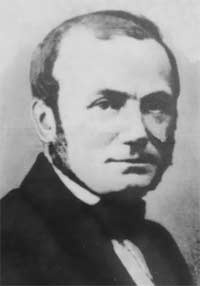
Isidore Geoffroy Saint-Hilaire was a French zoologist and an authority on deviation from normal structure. In 1854 he coined the term éthologie (ethology).

Étienne Geoffroy Saint-Hilaire was a French naturalist who established the principle of "unity of composition". He was a colleague of Jean-Baptiste Lamarck and expanded and defended Lamarck's evolutionary theories. Geoffroy's scientific views had a transcendental flavor and were similar to those of German morphologists like Lorenz Oken. He believed in the underlying unity of organismal design, and the possibility of the transmutation of species in time, amassing evidence for his claims through research in comparative anatomy, paleontology, and embryology. He is considered as a predecessor of the evo-devo evolutionary concept.
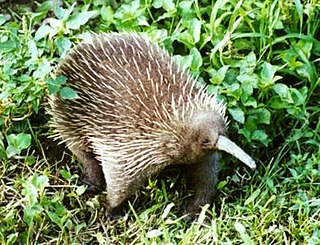
The long-beaked echidnas make up one of the two extant genera of echidnas: there are three extant species, all living in New Guinea. They are medium-sized, solitary mammals covered with coarse hair and spines made of keratin. They have short, strong limbs with large claws, and are powerful diggers. They forage in leaf litter on the forest floor, eating earthworms and insects.

Prionailurus is a genus of spotted, small wild cats native to Asia. Forests are their preferred habitat; they feed on small mammals, reptiles and birds, and occasionally aquatic wildlife.

The short-beaked echidna, also called the short-nosed echidna, is one of four living species of echidna and the only member of the genus Tachyglossus. It is covered in fur and spines and has a distinctive snout and a specialised tongue, which it uses to catch its insect prey at a great speed. Like the other extant monotremes, the short-beaked echidna lays eggs; the monotremes are the only living group of mammals to do so.
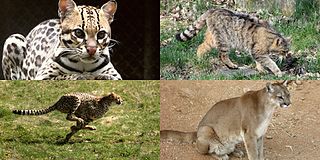
Felinae is a subfamily of the Felidae and comprises the small cats having a bony hyoid, because of which they are able to purr but not roar. Other authors have proposed an alternative definition for this subfamily, as comprising only the living conical-toothed cat genera with two tribes, the Felini and Pantherini, and excluding the extinct sabre-toothed Machairodontinae.

Pierre-Justin-Marie Macquart was a French entomologist specialising in the study of Diptera. He worked on world species as well as European and described many new species.

The western long-beaked echidna is one of the four extant echidnas and one of three species of Zaglossus that occurs in New Guinea. Originally described as Tachyglossus bruijnii, this is the type species of Zaglossus.
The echidna flea is the larger of two species of flea commonly found on the short-beaked echidna. It is monotypic, that is, the only species in the genus. This flea reaches 4 millimetres in length and has been claimed to be the world's largest flea. This statement is in error as the world's largest flea is known to be the mountain beaver flea which can be as large as 12 millimetres in length.

Zaglossus attenboroughi, also known as Attenborough's long-beaked echidna, is one of three species from the genus Zaglossus that inhabits the island of New Guinea. It lives in the Cyclops Mountains, which are near the cities of Sentani and Jayapura in the Indonesian province of Papua. It is named in honour of naturalist Sir David Attenborough.
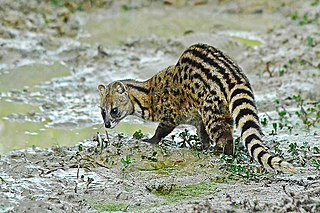
The small Indian civet is a civet native to South and Southeast Asia. It is listed as Least Concern on the IUCN Red List because of its widespread distribution, widespread habitat use and healthy populations living in agricultural and secondary landscapes of many range states.
Teleosaurus is an extinct genus of teleosaurid crocodyliform found in the Middle Jurassic Calcaire de Caen Formation of France. It was approximately 3 metres (10 ft) in length. The holotype is MNHN AC 8746, a quarter of a skull and other associated postcranial remains, while other fragmentary specimens are known. The type species is T. cadomensis, but a second species, T. geoffroyi may also exist. It was previously considered a wastebasket taxon, with many other remains assigned to the genus.
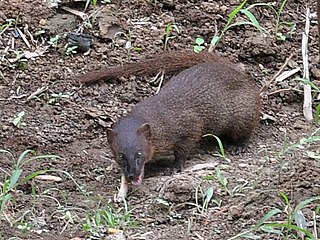
The Javan mongoose is a mongoose species native to Southeast Asia.
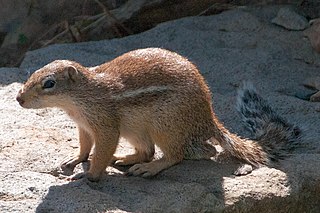
The striped ground squirrel is a species of squirrel native to Africa. It was first described by Geoffroy in 1803, but the binomial authority is sometimes incorrectly cited as "Desmarest, 1817". There are six subspecies. It is a moderately large ground squirrel with sandy-brown or dark-brown fur with a white lateral stripe and whitish underparts. Adults live alone or in pairs in a simple burrow with a central nest, foraging, mostly on the ground, for seeds, nuts and roots, and caching excess food under stones. This is a common species with a wide range and the International Union for Conservation of Nature has rated its conservation status as being of "least concern".

The gray flying fox is a species of flying fox in the family Pteropodidae. It is not to be confused with the grey flying fox. It is found in Indonesia, but not in the Philippines, despite occasional reference to such. Very little is known about this species. The gray flying fox has small size and neutral coloration with a brownish head and an orange abdomen. It probably roosts individually or in small groups. It was listed on appendix II of CITES, and is classified as "Data Deficient" by the IUCN. This species has been decimated by hunting for bushmeat in Indonesia. The hunters use fishing hooks, ropes, and other supplies to hunt the bats. The ropes and hooks are placed along their flight paths, tearing and ensnaring the bats' wings when are flying. In the course of a hunting season, entire colonies can be killed.

Mungos is a mongoose genus that was proposed by Étienne Geoffroy Saint-Hilaire and Frédéric Cuvier in 1795.

Monotremes are mammals of the order Monotremata. They are the only group of living mammals that lay eggs, rather than bearing live young. The extant monotreme species are the platypus and the four species of echidnas. Monotremes are typified by structural differences in their brains, jaws, digestive tract, reproductive tract, and other body parts, compared to the more common mammalian types. Although they are different from almost all mammals in that they lay eggs, like all mammals, the female monotremes nurse their young with milk.

John Thomas Tunney (1870–1929) was a naturalist and collector of animal specimens, active in the west and north of Australia.
The monotremes represent the order of extant mammals most distantly related to humans. The platypus is indigenous to eastern Australia; the short-beaked echidna is indigenous to Australia and Papua New Guinea; whereas the long-beaked echidna is restricted to Papua New Guinea and Irian Jaya. Since monotremes exhibit characteristics common with both reptiles and therian mammals, they are of great interest for the study of mammalian evolution.
















